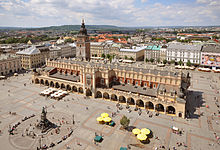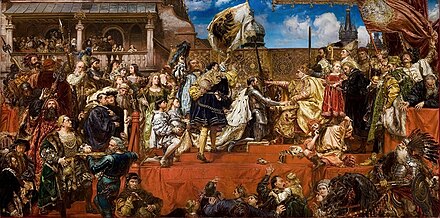Main Market (Krakow)

The main market (also ring , Polish : Rynek Główny ) in Krakow , the second largest city in Poland , forms the center of the old town. It was laid out in the 13th century and, with an area of around 40,000 m², is one of the largest medieval squares in Europe.
The ring (market square) is square , with sides of 200 meters each, and is framed by palaces and churches. The center of the square is occupied by the Cloth Hall , which was rebuilt in 1555 in the Italian Renaissance style. On one side of the Cloth Hall are the approximately thousand-year-old Romanesque St. Adalbert's Church and the Adam Mickiewicz monument from 1898, on the other side the town hall tower . The square is dominated by the Gothic towers of the Marienkirche .
history


The main market was created for trading purposes. Krakow was established in 1241 by the Golden Horde destroyed and received in 1257 under Boleslaw V the Magdeburg Rights , which stresses the importance for trade increased. This year the square was laid out in its current form. It originally contained numerous low market halls and was surrounded by administrative buildings and a road ring. Casimir the Great had the originally Gothic cloth halls and the town hall built, which took up about a quarter of the square and was demolished in 1820. At that time Krakow was the capital of the Kingdom of Poland , a member of the Hanseatic League since 1387 and a flourishing European trading center.
In addition to its trading functions, the main market has witnessed numerous historical events. Due to its location on the Royal Route , diplomats and foreign dignitaries met here for coronation celebrations on the way to the Wawel . Casimir the Great convened the Kraków Congress here in 1364 , at which nobles from all over Europe came together. On the occasion of battles won over the Grand Duchy of Moscow , a victory parade was held in 1514 by the Lithuanian Prince Konstantin Iwanowitsch Ostroschski and another in 1531 by the Polish nobleman Jan Amor Tarnowski . On April 10 1525 kneeling down was Duke Albrecht , the so-called Prussian Homage , before the Polish king I. Sigismund instead. King John III Sobieski celebrated his victory over the Ottomans here after the Battle of Kahlenberg in 1683.
After Sigismund III. Wasa moved the Polish capital from Krakow to Warsaw in 1596 , coronations and royal burials continued to take place in Krakow. On March 24, 1794, Tadeusz Kościuszko took the oath to liberate Poland from the invading powers on the main market, which triggered the Kościuszko uprising .
During the German occupation of Poland in World War II , the name was changed to Adolf-Hitler-Platz . The Adam Mickiewicz monument was destroyed and rebuilt after the war.
In 1978 the square was added to the UNESCO World Heritage List as part of Kraków's Old Town . On 21 March 1980 political moment voltages 1981 imposition of martial law led to chained Walenty Badylak (1904-1980), a baker retired and veteran of the Home Army , in protest against the official concealment of the Katyn massacre to a Well, which bears his name today, poured gasoline over himself and died from self-immolation .
Today's usage and events
Numerous cellars have been set up as restaurants or cafes. The basement of St. Adalbert's Church contains a small archeology museum. The Piwnica pod Baranami cabaret is also located in a vaulted cellar . In 1876, Anton Hawelka opened the Café Pod Palmą ("Under the Palm"), which still exists today .
The main market is the scene of numerous public events and festivities. These include the annual Krakow Christmas crib , Lajkonik parades , gala concerts by the Great Christmas Aid Orchestra and the country's largest New Year's Eve party .
photos
Individual evidence
- ↑ The Rynek and its surroundings (English)
- ↑ Wroclaw and Cracow in the High and Late Middle Ages, p. 243
Web links
Coordinates: 50 ° 3 ′ 42 ″ N , 19 ° 56 ′ 14 ″ E






